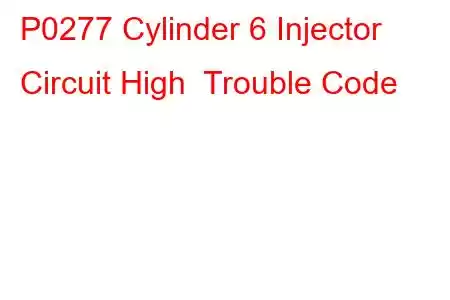P0277 Cylinder 6 Injector Circuit High
OBD-II Trouble Code Technical Description
Cylinder #6 Injector Circuit High
What does that mean?
This diagnostic trouble code (DTC) is a generic powertrain code, which means that it applies to OBD-II equipped vehicles. Although generic, the specific repair steps may vary depending on make/model.
Trouble code P0277 is a generic code (common to all manufacturers) denoting an above average current draw from the fuel injector servicing the number six cylinder.
The engine cylinder #6 injector is operating poorly or not at all due to a problem within the circuit. It may be noted that although this code is common to all vehicles, the prognosis may vary between manufacturers.
For example, they may have been experiencing problems with a batch of fuel injectors, or some other defective item within the circuit limited to their particular vehicles.
This type of problem is better addressed as soon as possible to prevent damage to other internal components. A bad fuel injector will effect the spark plug, cause detonation, effects the oxygen sensor and catalytic converter, and several other components as well.
Go online and access the technical service bulletins (TSBs) for your specific vehicle. Look for any TSBs relating to P0277 and their suggested repair procedure.
Cross-section diagram of a typical automotive fuel injector (provided by WikipedianProlific):
Symptoms
The symptoms displayed for a P0277 code may include:
The malfunction indicator light will illuminate and code P0277 will set The engine will run rough at idle The fuel economy will suffer There will be a lack of power indicated by poor accelerationCauses
Potential causes for this DTC include:
Faulty electrical harness from the PCM to the injector Faulty electrical connector on the fuel injector Internally shorted fuel injector causing a high-voltage draw Plugged or dirty fuel injectorDiagnosis and Repair Procedure
It's been my experience over the years, that the problem is typically a corroded or loose fuel injector connector, or a faulty fuel injector.
A loose connector causes excessive resistance thereby increasing the voltage necessary for operation. The wiring harness to the powertrain control module (PCM) is not easily accessible, and left undisturbed is seldom faulty.
The fuel injector, on the other hand, is susceptible to a variety of problems. The number one problem is fuel with anhydrous ethanol content. This fuel additive reduces the oil base fuel consumption.
The water vapor produced with E10 anhydrous ethanol has an adverse effect on the fuel injectors. They rely on fuel for lubrication. Water vapor reduces the friction reducing attributes of gasoline and causes premature wear in the injector.
Small engine manufacturers do not endorse the use of ethanol based fuels as they significantly reduce the service life of a small engine.
Inspect the electrical connector on the fuel injector. Look for bent or pushed out pins. Install some dielectric grease and push the electrical connector on the fuel injector. Make sure it is a tight fit and the metal spring retaining clip is in place Start the engine. Place a long screwdriver handle to your ear and the tip on the fuel injector. A clicking sound indicates a working injector. No sound is the opposite Disconnect the fuel injector. With an ohmmeter, check the resistance between the two male terminal blades. A good injector will have 0.5 to 2.0 ohms. More or less ohms indicates an injector with an internal short. If the resistance is correct and the injector could be heard operating, the next step is to attempt to clean the injector. If cleaning fails to restore the injector to normal operating parameters, the only alternative is to replace the injector. Purchase a 'direct injection cleanerRead: 43


